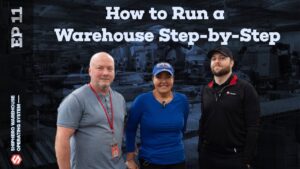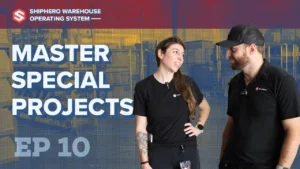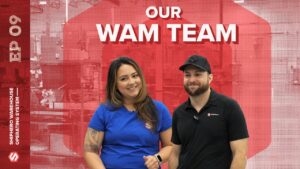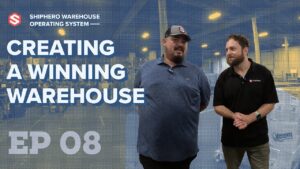Video Transcript
Host (00:06):
Hello everyone, and welcome to another episode of ShipHero Feature Walkthrough. Today I have the honor to be joined by Yosef, our ShipHero VP of product. How are you today, Yosef?
Yosef (00:16):
Hello. Good, how are you doing?
Host (00:19):
I'm glad. I'm glad to have you here. And today we're going to learn about Bulk Ship, right?
Yosef (00:25):
Yep.
Host (00:26):
So please enlighten us on Bulk Ship.
Yosef (00:30):
Bulk Ship is a great way to ship a lot of orders very quickly. The idea behind it is, if you have a lot of orders that are identical, you can essentially create a batch of those orders and basically just print out labels, and then it's easy to just pack them up and ship it out. So some people might have a drop where they release a product and they get maybe 10, 100, 1,000 orders the exact same. So instead of going through the batch picking where you're essentially picking the same thing over and over and over again, you can create this batch, you'll get a stack of labels, and then you just have an assembly line putting it in a box or envelope, slapping a label on.
(01:11):
Because they're identical you don't have to worry about looking at what's in the order. You just know every label that you have is for the exact same thing, and it becomes a lot quicker, a lot more efficient to pack and ship those orders. And I can walk you through that, kind of show you the way it works, and talk about some different scenarios that we see that make Bulk Ship efficient.
Host (01:33):
Sure. Yeah, please do.
Yosef (01:35):
All right, so as you can see I have the Bulk Ship page here, and the first thing you'll see is the suggested batches that we've seen in your order. So what we do is we essentially look at your orders that are ready to ship, and we see which orders or how many identical orders are there, and we sort that by the number of orders. So you can see we found 21 orders that have just one of the Hershey's Bar. And you can see this little one here that tells you how many, because you notice on the second line there's 17 orders where there's one of the French onions on ships, and one of the whole grain ships. And then you can see the rest, 16 of this, and it goes down to where there's just one. Now, obviously when there's only one or two or 10, probably not worth doing Bulk Ship. It's good to just do those orders in your regular batch picking. Bulk Ship, you really want to knock off the orders that have a lot.
(02:27):
Now, what a lot means can vary depending on the situation, depending on the types of product it is. But we usually see bulk work well for more than like 30, 40 orders that are the same, and it can go up to thousands. So we do limit it to 500 per batch, and that's just for processing. It does take time, obviously, to generate each one of those labels. So you can get a stack of labels, 500 labels, and then just do the next 500 to give to someone else. So this way you get it faster. If we were doing 1000 or 2000 orders at once, it would just take longer to complete that whole batch. So in this case it just has some test orders, but you can see a couple different quantity of orders.
(03:10):
A few other things about this page, you can search for an item. So if you know that there's a specific item that you want to Bulk Ship, you can search for it, just go here and find the item you want. It'll say I think, "Oh, well, maybe I have some corn chip orders." You can search for that. I don't have any so I'm not going to find any results, but there is the option to look for specific products that you may want to Bulk Ship.
(03:32):
Those will save suggestions. This is a way to have a quick place to see if any of these common products have orders to Bulk Ship. So you can see I have two examples here. The Lay's potato chips, we have one order, and the nacho cheese tortilla chips, we have zero orders. So this might be, if you know that you typically get these certain products that are good for Bulk Ship, you can save them. And the way to save them is just on the right side here. As I suggested, just click on this little flag here and then it'll save it here. So you can come here, get a quick look, say, "Okay, these are my products that I normally Bulk Ship. Are there enough orders, or are there orders to Bulk Ship?" And you can create the batch from there.
(04:14):
This last tab for batches, we'll get back to this, we'll show you completed batches that you've done. And I have some examples here to look at. So once you do want a Bulk Ship, you just click into the batch. And a lot of information on this page, so we'll go from the top and talk about what every section means. The top section is just an overview. So we have our 21 orders, there's one item per order, which means there's 21 items to pick. So it's going to give you a summary of how many items, how many orders you're going to pick.
(04:42):
And then we estimate the order weight. And this is based on the product. So this product we have in as 0.1 pounds, so the weight of the order would be 0.1 pounds.
(04:53):
Next it tells you, okay, where are we picking the items from? Now, if there were multiple items on the order, and let me pull one up just to show you, it'll show both those items there. So go to this other batch, you can see you have both items. If there were lots on these products, lots of expiration, we show that here. And it gives you a summary of where to get the product from and what you have in that location. You can change that, so if I say, okay, well, it's telling me to pick this product from A20101, but I know I want to pick it from somewhere else, you can just click on there and click on a different location, choose that location to pick from.
(05:31):
We will also show you which locations you have that product, but maybe you don't have enough in that location. So we do highly recommend that when you create a batch, there's enough inventory in the location to fill the entire batch. And if that means transferring, you can do that. But what you don't want is if I have 30 units to ship and I have one location with 15 and one location with five and one with two and maybe a few others, there's no good way to say, "Well, first pick 15 from here, and then pick next five from there, and then the next two from there." There's no way to say that, so best idea is just transfer enough inventory into one location and then choose that location to pick truck.
(06:15):
You can choose a non-pickable location. So especially when you get to the batch of the 300, 400, 500 products, if you want to pick from your overstock location, maybe you have a palette you're going to bring down just for this purpose, that will show up here. We just show you whether it's pickable or not. You could choose a non-pickable location if you want to go from there.
(06:36):
So once I see where I'm picking from, I have two things I can do. One thing you can do is print a picking list. And this is something you can print out, give to somebody in the warehouse, and basically just say, "Go pick this, bring this to the prep area." And again, this is just a pick list. It's not in the mobile app, so the picking in Bulk Ship is not in the mobile app, but basically you can give that to somebody to go pick.
(07:00):
Next you're going to basically create one sample order. And this is a way just to confirm, make sure you have everything correct. You can scan here. If you have a barcode scanner you can just scan the barcode, it'll confirm that. Otherwise, you can just type in, make sure that you're doing the correct quantity. And this is just a way to check yourself, make sure you're doing that. So here you can see I needed two of this product and I only put in one. So it gives me this little arrow, say, "You're short one." Okay, I have two, and I should be good.
(07:28):
Then I would choose the box that I'm putting it in. In this case I'll just use my stack box, put some dimensions, add the weight. This is your one sample order just to make sure you have everything correct. And remember, since they're identical, every box should have the identical weight, identical dimensions inside there.
(07:48):
Now, the bottom here, this will show me the orders that I'm going to be picking. So you can see all the orders here. You can remove orders if you want, so I can say, "Well, only show me the orders in a certain status," and maybe I only want to ship a certain carrier so maybe I just want to do my cheapest options now. So that's going to filter out any FedEx or any other ones that I have. Then I can create a batch with just those orders. If I hadn't done that, you can see in the bottom I have some FedEx ones, and I can click on these and remove them manually as well. So I can say, "Well, I'm going to remove those from this batch." So there's a few ways to edit or change the batch that we suggested. You can also click on a few and say, "Well, I just want to do these three." So again, if you don't check anything, it'll include all the orders. Otherwise, you can choose specific orders to generate.
(08:38):
Now, if I had, I'm just going to check all of those and I'll say, "Generate labels for 15 orders." And when I do that, it's going to give me three options. Generate labels, labels and invoices, or labels and invoices separately. If I do labels, I'm going to get a PDF of just shipping labels. If I do labels and invoices, it can give me a PDF with a label and then an invoice, and then the next label with the next corresponding invoice. And that'll all be on the same four by six label. If I do separately, I'll get two papers or two PDFs, one with the labels and one separately with the invoices. So that's something where you have to match them up, but if you do have different paper, different type of print, you may want to create them separate.
(09:22):
I will say that most people either do labels and invoices in the same or just do labels. I just don't do a packing slip or invoice with Bulk Ship. Once I'm ready, I'll just do generate labels. So it's going to go through each order and generate the labels.
(09:39):
Now, you'll see on some of these I got an error, and some of these I got a tracking number. So if I got a tracking number, that's good to go. The error ones, you can actually just hover over it, click on it, and it gives me the error. So in this case, my FedEx scan wasn't correct, your meter number is wrong. So I have a few different options before I can print the batch. I can select these and just say, "Remove from batch," or I can edit the shipping method. So if I edit the shipping method, let's say I want to change that to my UPS, but UPS Ground. And then what I can do is reprocess.
(10:12):
And once I reprocess, that'll retry the labels that failed and see if we can get it out. So we'll give that a minute to process. There we go. And as you can see, it's reprocessed and all those orders have updated, and I have tracking notes. So once that batch is complete, this button changes to print labels. And when I click on that, you'll see I'll get a PDF with all my labels. So here's my UPS labels.
(10:43):
And you notice the first label I have here is kind of a batch summary. So this is again something you can give to your picker. If you didn't use the pick list that we didn't show before, you can use this as well. And this shows location, shows the product, how many they need. You could put in who is the picker, who is the packer. And some companies will save this, file it somewhere just to have a record of who picked this batch, who packed it, maybe sign off on it. Then you do have a similar label at the end here, just a footer sheet to again summarize what's on the batch.
(11:19):
Now, once this is done, I would just send this to the printer, just a print, send this to my label printer. And this is one file, so there might be 500 labels on here. It'll come out fast because it is one file. We're not sending each label separately to the printer. It's one file and it should print pretty fast.
(11:35):
Any questions so far, Danno?
Host (11:37):
No, no. It's super intuitive.
Yosef (11:40):
All right, great. So a couple of things just to show you. Let me refresh that. Back on this batches page you'll see a list of the batches I've generated before. So you'll see the one that I just did, that one's been shipped, labels have been printed. I have two other batches here. This one's ready to print, which means it's been fully generated but I haven't hit print labels. So you might want to come in the morning, create your batches, but then leave it for someone in the warehouse to actually print them. That is an option. They can always come to that page and see what has not been printed. And you can filter by that, so say, "Okay, what's ready to print?" And this way they know these are the ones they need to print and pack.
(12:23):
And then we have that error one, or an error one that I generated before. Again, just some examples. You can always come here and say, "Remove from batch."
(12:31):
We also have the option to put the order on hold. So if there's an issue and you want to put the order on hold, you can remove it and put the order on hold. And then of course there is that other label that I had that will generate, but if there is an error, in this case there is an issue with the address. So again, a couple of things I can do. I can click on this order number and edit the address right here. So you can see in this case the state got left out and the country got left out.
Host (13:00):
Right.
Yosef (13:00):
I can update it right here on the Bulk Ship page. I don't need to go to the dashboard. You can update it, reprocess, and try that again.
(13:08):
Another option I have is, let's say I've generated a batch and I realize I don't want to ship this. So I can void the label right here, and then I do have the option to reship the order, which will reset the order. And I can also remove the order from the batch. So if an order got in that shouldn't have, I can void it, remove it from the batch.
(13:27):
You also have the option of canceling the entire batch. And by doing that it will void the labels from the batch, remove them, remove those orders from the batch, and then they can be shipped another way. So even though you've created those labels, you do have the option still of voiding and removing those orders from the batch.
(13:44):
And that's about it. Bulk Ship can be very, very useful, so if you're not using Bulk Ship, definitely think about what orders could fit. So again, what products do you get orders where there are a lot of identical orders?
(14:00):
I do recommend usually doing Bulk Ship first, so come in the morning and do Bulk Ship, because that'll just remove those orders from the batch picking that you might do. So it's a good idea to get those out of the way first so you're not picking these single item orders or identical orders with your batches.
Host (14:17):
Sounds great. Yeah, that's actually super useful.
Yosef (14:23):
It is. A lot of customers use Bulk Ship pretty extensively. There are definitely Bulk Ships of hundreds of orders at a time. So if you're not using it already, definitely recommend checking it out.
Host (14:35):
So thank you very much, Yosef. And if you're ready to unlock your ecommerce fulfillment superpowers, visit shiphero.com to schedule a call with us. And obviously be sure to share, like, and subscribe for more content. And thank you, and have a great day.
Yosef (14:50):
Thank you.



